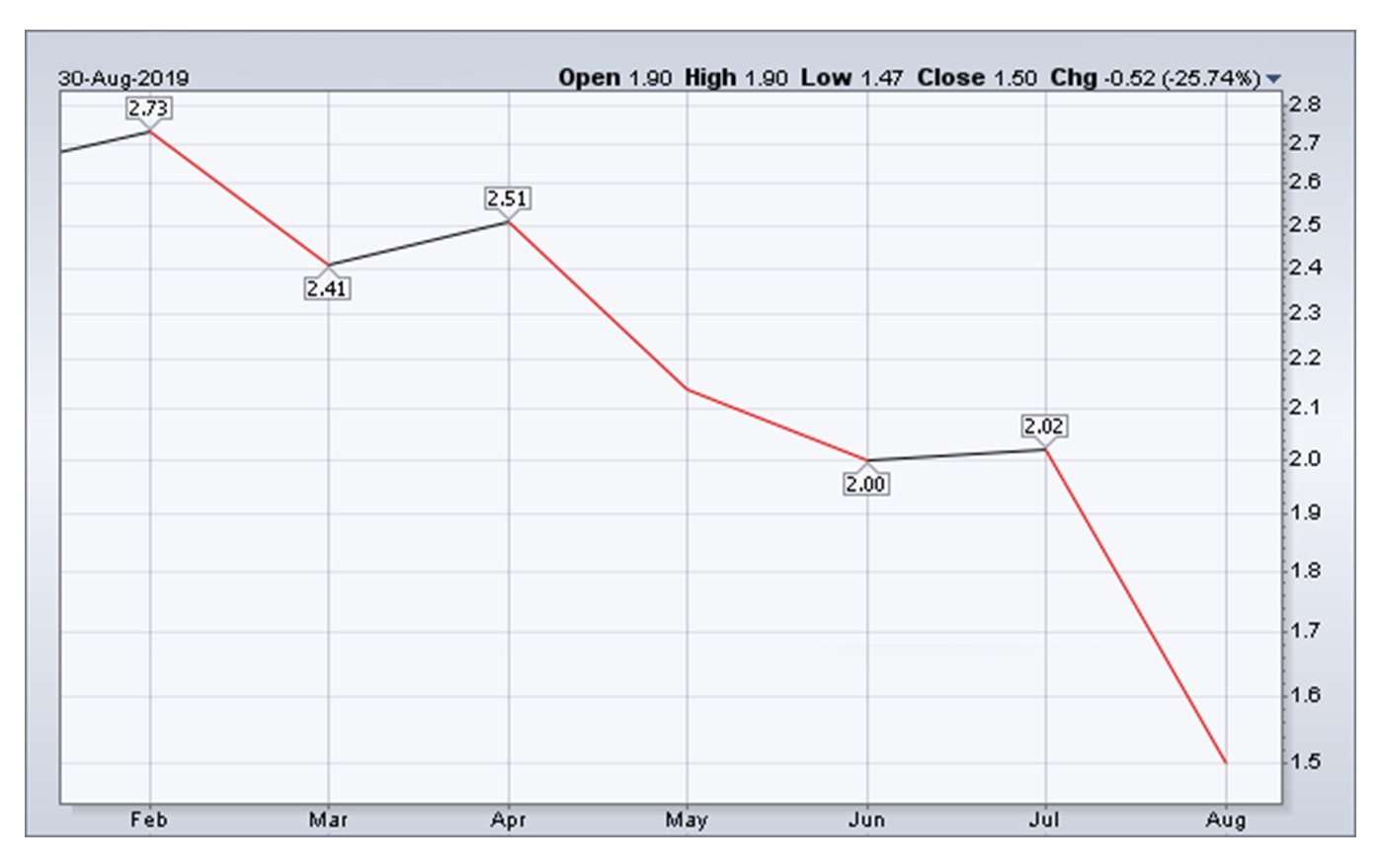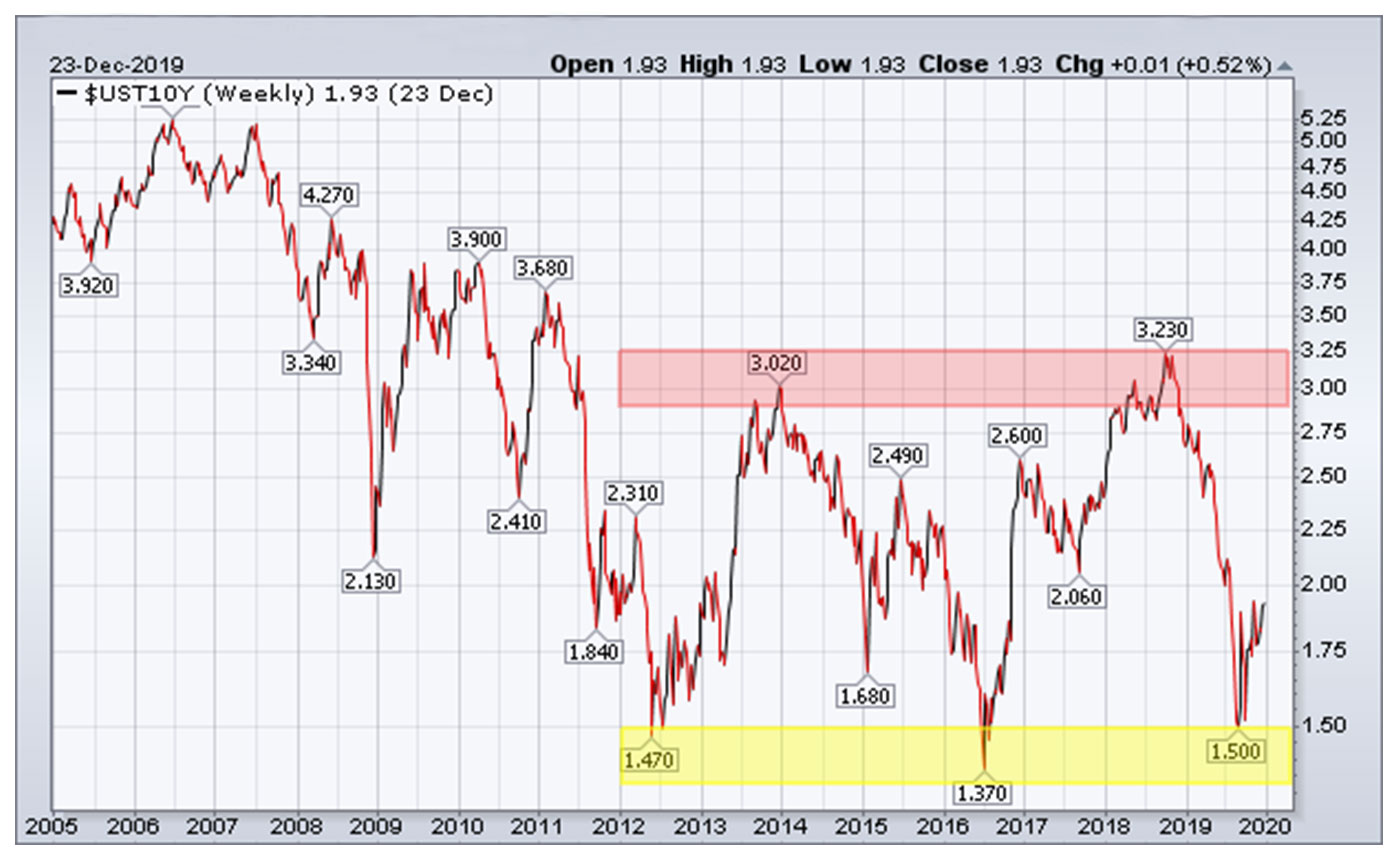Navigating higher interest rates in 2020
Navigating higher interest rates in 2020

The topics of Fed interest-rate policy, inflation, and bond yields have been front and center for several years. How can proactive advisors guide their clients amid uncertainty in 2020 for the bond market—and other asset classes?
I often tell our clients that markets have a knack for trading beyond the limits of imagination, and that was on full display in 2019.
While the S&P 500’s astounding “V” bottom gets most of the attention, for me it was the jaw-dropping plunge in interest rates across the yield curve that snagged the title of 2019’s “most unimaginable move.”
Consider the following: The yield on a 10-year United States Treasury bond (UST10Y) declined 45% in just six months, from February 2019’s monthly close at 2.73% to August 2019’s monthly close at 1.50%. That is the single largest six-month decline on record for UST10Y since 1970. Heck, UST10Y declined 25.7% in the month of August alone! That too was unprecedented as it is the single largest monthly decline on record for UST10Y since 1970, eclipsing November 2008’s decline of 25.5%. So, anyone who said they saw this coming is probably fibbing.

Source: Market data, StockCharts.com, S. Deppe
The narrative behind UST10Y’s plunge this year was a trifecta of a slowing global economy, low inflation, and an avalanche of easing—collectively—from global central banks. The actions of global central banks in 2019 are best exemplified by comparing the Fed’s own language from December 2018 to December 2019.
Here’s a snippet from Jerome Powell’s press conference in December 2018:
“Many FOMC participants had expected that economic conditions would likely call for about three more rate increases in 2019. We have brought that down a bit and now think it is more likely that the economy will grow in a way that will call for two interest rate increases over the course of next year.”
Here is a statement from Mr. Powell’s December 2019 press conference:
“Rather than modestly increasing the target rate for the federal funds rate this year, as seemed appropriate a year ago, we reduced it by 3/4 percentage point. This shift has helped support the economy and has kept the outlook on track.”
When charting UST10Y, we can see that it is completely range-bound between the 1.5% and 3% regions. It’s clear that participants, collectively, find 10-year Treasury bonds attractive when they’re offering 3% or higher interest, and relatively unattractive when they’re offering 1.5% interest. It’s been one giant rectangle over the last seven years. UST10Y has at least stopped going down.
While trading ranges, or rectangular chart patterns, are notoriously difficult to forecast, we can still speculate about the two extremes UST10Y might be headed to in 2020—back to the upper end of the range at 3% or higher, or perhaps down to the 0% level like many of our European counterparts? Both seem somewhat hard to conceive of right now, which means there’s a better chance than most believe that we will see one of these levels in 2020.
FIGURE 2: 10-YEAR US TREASURY YIELD (2005–2019)

Source: Market data, StockCharts.com, S. Deppe
If the variables most influencing UST10Y’s path in 2020 remain the state of the global economy, inflation outlooks, and expectations for forward-looking global central bank policy, then I think it’s more likely that UST10Y revisits the 3% region in 2020, perhaps even trading beyond 3%, rather than trading down to fresh new all-time lows below the 1.5% region.
First, the global economy is stabilizing. The S&P 500 skyrocketed to new all-time highs in the fourth quarter, U.S. business activity has picked up, the manufacturing sector shows signs of steadying, and there’s less uncertainty on the trade front than there was a couple of months ago.
Across the pond, there’s far less uncertainty on the “Brexit” front, and more and more countries are seeing their own equity markets reverse course to the upside. In Japan, the Nikkei is at a 20-year high; in Europe, the FTSE 100 stock market index is positioned to break out to decisive all-time highs; and even the Taiwan stock market is flirting with new all-time highs, something that hasn’t been seen for decades. In terms of sentiment, the fear of a global recession has almost vanished relative to where it was in the summer months of 2019. Collectively, the price action across asset classes is seemingly telling us there’s no recession coming in 2020, at least as of today.
From an inflation expectation and global central bank standpoint, the Federal Reserve is openly telling us they want more inflation. The late, great Richard Russell, the author of Dow Theory Letters, wrote often that global central banks would draft monetary policy decisions under the guise of “inflate or die.” That is, global central banks will do anything and everything to avoid a deflationary spiral choking their local economy, even if meaningfully ascending inflation is the consequence. New York Federal Reserve President John Williams even went as far as saying that low inflation is “the problem of this era” earlier this year. And referencing back to Powell’s press conference from December 2019, he mentioned the word inflation 79 times—and it was almost always in the context of the Fed striving to create more inflation. Regarding future increases to the federal funds rate, Powell stated,
“And in order to move rates up, I would want to see inflation that’s persistent and that’s significant—a significant move-up in inflation that’s also persistent before raising rates to address inflation concerns. That’s my view.”
There’s no doubt the bond bull market has exceeded the limits of imagination over the last few decades.
The Vanguard Total Bond Market Index Fund (ticker symbol VBMFX) has increased 26 of the last 29 years since 1990, and 2019 has seen another stellar year for the fixed-income asset class.
There aren’t many long-term investors, or even analysts, who would have imagined this type of advance in 1990. However, this is the view through the rearview mirror, not the windshield. Advisors building portfolios based solely on what worked best in the past, such as a simple basket of stocks and bonds, instead of evaluating the opportunities in the present, are probably going to struggle to help their clients generate the returns they need into the future. In 1990, UST10Y was hovering in the 8%–9% range, while in 2020 UST10Y is hovering in the 1.5%–3% range. Fundamentally, this time is different, and the next few decades for the fixed-income asset class, and interest rates, won’t look anything like the last few decades. Proactive advisors need to take this into consideration as they design and implement portfolios for the long term.
It’s also imperative that advisors understand that rising interest rates into the future affect all asset classes, not just the fixed-income category. There’s little doubt that the Fed’s zero-interest-rate policy (ZIRP) for much of the last decade has created a distortion in capital allocations across asset classes since, as the saying goes, “There is no alternative” (TINA). Stocks and bonds have been the beneficiary. Should UST10Y head back toward 3% in 2020, and perhaps even breakout beyond 3%, one can argue the days of ZIRP and TINA are behind us. If so, that would mean there will be alternatives into the future. Here are a few tips we can consider to help take advantage of them:
1. Short duration. Broadly speaking, the higher bond prices climb, and the lower interest rates go, the less attractive owning any meaningful duration becomes. Since UST10Y collapsed in 2019, it makes sense to consider owning less duration as we head into 2020. This also enhances liquidity and fuels favorable re-investment opportunities in the event interest rates do rise.
2. Leverage defined maturity. The days of building portfolios only using broad baskets of bonds with varied maturity are behind us. Consider evaluating the advantages of defined maturity exchange-traded index funds or separately managed accounts, where your clients can own the actual underlying securities. This can help advisors tailor and evaluate modern-day barbell approaches to diversify away from binary bets on where UST10Y is headed. If the bond market has truly topped, you don’t have to experience death by a thousand cuts by passively owning perpetual maturity bond funds.
3. Reach for yield, selectively. Sourcing from the public fixed-income markets and the private fixed-income markets can enhance returns without compromising the integrity of the underlying investments. There are reasonable yields out there where you’re compensated handsomely for the risk you take—you just must proactively look for them. This is what our clients compensate us for, and we must do the work.
4. Source away from bonds/fixed income. It’s 2020, and prudently designed portfolios don’t include only stocks and bonds. Contrary to popular opinion, you don’t have to invest 20%–40% of your portfolio in bonds. Many alternative, uncorrelated asset classes and investment strategies exist that can help investors more effectively diversify their portfolios, rather than just accepting low interest rates on a piece of their investment pie. Third-party managers are beyond valuable here, as they can help you build more intelligent portfolios with more durable asset allocations for your clients and can also offer a multitude of tactical strategies.
5. Watch gold. While gold has not been a perfect hedge against inflation over the long term, it’s been a wonderful shorter-term hedge against inflation while inflation is ascending. Federal Reserve Chairman Powell has all but guaranteed that the Fed’s going to play catch up, i.e., the Fed’s not going to raise the federal funds rate until inflation’s running. This should lead to a period of negative real interest rates, which should help spark gold prices. We don’t know when this period will be, and we certainly can’t predict it, but gold sent a message in the summer of 2019, and one that I think will resonate a bit more in 2020.
6. Overweight tactical, underweight strategic. Broadly speaking, strategic asset-allocation methodologies have mostly outpaced their tactical counterparts over the last decade. However, I think this has been a derivative of ZIRP and TINA, which helped propel persistent returns for bonds and provide a floor for stocks during the most volatile climates (think one year ago).
In an environment of rising interest rates, I’d anticipate bonds to underperform as a category and stocks to be far more volatile with much lower forward-looking annualized returns. For example, GMO’s forecast for the next seven years shows negative returns on average for U.S. large- and small-cap stocks. Such estimates are generally a derivative of a substantial drawdown occurring for equities over the time period forecast. Moving forward, it’s imperative that investors attempt to win by not losing during a climate of rising interest rates. That’s where tactical asset allocation thrives. Importantly, tactical asset-allocation strategies are not equity exclusive.
In summary, we all strive to build portfolios that will help our clients generate the annualized returns they need to achieve their financial goals. We’ve had it relatively “easy” the last decade, and it’s undoubtedly going to be more difficult the next decade. Passively owning stocks and bonds isn’t enough to thrive during a bear market for bonds, and I think we will first see a bear market in bonds before we see a bear market in stocks.
Be proactive and be prepared for any pitch the markets might throw you, especially the pitch that includes rising interest rates into the future.
The opinions expressed in this article are those of the author and do not necessarily represent the views of Proactive Advisor Magazine. These opinions are presented for educational purposes only.
This material is intended for industry professionals and is not intended to be relied upon as a forecast or investment advice, and does not constitute a recommendation, offer, or solicitation for any specific security or any specific investment strategy. Investment advice is only provided within the context of a written advisory agreement with a client. This material represents the current market views of the author, and there is no guarantee that any forecasts made will come to pass. Due to various risks and uncertainties, actual events, results, or performance may differ materially from those reflected or contemplated in any forward-looking statements.
 Steve Deppe, CMT, is a principal and senior market strategist and wealth advisor at Nerad + Deppe Wealth Management, based in San Diego, California. He began his career with American Express Financial Advisors and was a manager for several years with Ameriprise Financial. Mr. Deppe is a CMT (Chartered Market Technician) charterholder and a member of the CMT Association. He is also a member of the American Association of Professional Technical Analysts (AAPTA).
Steve Deppe, CMT, is a principal and senior market strategist and wealth advisor at Nerad + Deppe Wealth Management, based in San Diego, California. He began his career with American Express Financial Advisors and was a manager for several years with Ameriprise Financial. Mr. Deppe is a CMT (Chartered Market Technician) charterholder and a member of the CMT Association. He is also a member of the American Association of Professional Technical Analysts (AAPTA).
